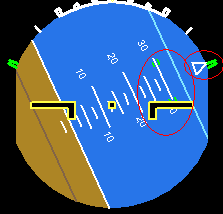
Copyright D.P. Browne 2011
Flight Control Modes & Laws
The normal law is one where the flight crew modify the aircraft attitude with the side stick input, but once the side stick is released, the flight control computers maintain the aircraft in that attitude. The pitch trim is automatic and the there is little change of aircraft response by speed, weight or center of gravity location.
Normal Law
If more than 2 failures occur in the PRIM and SEC, then the flight control laws revert to the Alternate Law. In the alternate control law, the pitch and roll attitude limit is lost .
Alternate Law
Further degradation of the flight control system, produces the direct law. This is a conventional aircraft where the side stick inputs directly control the surfaces. There is no over speed, alpha floor protection and pitch trim is manually performed using the pitch trim wheels.
Direct Law
The flight control system has 3 control laws, Normal, Alternate and Direct. If there is a complete loss of electrical power, then the aircraft can be maintained in steady flight by the use of the rudder and THS.
Next
Previous
Ground Mode
Flare Mode
Flight Mode
Ground + 5 sec
Radio Alt > 50 ft
Radio Alt < 100 ft
In the Ground mode, the flight crew’s sides tick inputs are sent directly to the surfaces, much like a conventional aircraft.
In the Flare mode, the flight control system limits bank angle and provides angle of attack protection.
In the Flight mode, the flight control system limits bank angle and provides angle of attack protection, high speed protection, load factor limitation and attitude limits.
Over speed protection is provided by increasing the pitch attitude to maintain less than VMO/MMO. Similarly, alpha protection will cause nose down attitude changes to prevent stall.
In the normal law, the pitch attitude and bank angle is limited. The attitude limits appear as green lines on the ADI.






